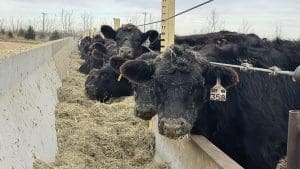By Heather Smith Thomas Contributing Editor

Cattle prices are at an all-time high and rising. Some cow-calf producers are sending calves to market right off the cows rather than put time and money into vaccinations and preconditioning. Yet these are still ways to add more value to calves.
David Anderson, Texas A&M University professor and Extension economist, says even though some people will just “take the money and run” the choice of strategies is huge. “Some cow-calf operations normally hold calves longer to background and put more weight on, and that’s what they’ll keep doing,” he says.
“Some are flexible and may change marketing tactics from year to year. Some will be grabbing prices earlier rather than waiting. Price spreads/slides from calves to feeders have historically been wide. On a market like we have today, this encourages people to sell; I think we’ll have more selling right off the cows.”
There is always risk involved if you keep them longer. “Maybe they won’t gain enough weight [for the amount of feed put in them] or some might get sick or die,” Anderson says.
If you sell calves right off the cow, you pass the risk to the buyer.
“High prices make risk more expensive, which encourages people to sell. Some areas of the country, however, had rain and have a lot of grass. It’s an opportunity to let calves eat it and put on weight, and sell more pounds later,” he says. Stockmen with adequate inexpensive feed may decide to keep them.
Buyers prefer weaned, preconditioned calves that might stay healthier. “With calves so expensive, you’d think this would boost the premium for preconditioned calves, but from what I’ve heard, some of those price differences have been small,” he says.
Some feedlots are so short on cattle they are willing to take some risk.
“We have fewer numbers, so if you need to have cattle on feed, you have to pay to get them,” Anderson says. “This has squeezed preconditioning premiums. It’s also hard to have the premium a lot bigger than the cost of preconditioning. If it is profitable, more people do it, boosting the supply of those calves and bringing premiums down.
“A decade ago when we had record-high prices, we saw premiums smaller, partly because cattle numbers were so few that people paid a lot of money just to get them. I’m not saying various backgrounding programs won’t work or won’t pay, but high prices do encourage people to just sell their calves!”
With heifer calves worth a lot, some producers hesitate to keep replacements. “Do I take a check today vs. waiting several years until the heifer has calves and what she might earn over her lifetime?” Anderson says. “At what point do future returns look more promising than what those heifers will bring right now? I think that’s part of the reason we’re seeing such slow herd expansion.”
Derrell Peel, Oklahoma State University Extension livestock marketing specialist, says prices will likely move even higher, but value-added programs still pay.
“If profit maximization has been your goal, continue to do things to maximize revenue,” Peel says. “Even if you don’t, you’ll probably make more money now than you have in a while, maybe ever, but you could make even more.”
Some of the niche markets (higher-than-average prices when the market is down) may not rise as high as quickly. “Specialty markets have probably not gone up as much proportionately; this premium has narrowed, but producers in these programs will probably continue to sell cattle this way,” he says.
Once you establish a market and reputation, most people want to keep it – and continue receiving a better price when the general market drops. You don’t want to undo the progress you’ve made in developing a program.
With tight beef supplies supporting higher prices all the way to the consumer, niche markets may keep up with the higher prices this time because we’re not producing as much beef; demand is much greater than supply.
“People selling direct or into niche markets may have to think more about how much and how fast to raise their prices to keep up with the underlying market, but I suspect they will have some ability to do that,” Peel says.
Livestock Risk Protection Insurance
Brett Wilder, University of Idaho Extension educator, says with prices this high, more people are utilizing price risk management programs like livestock risk protection insurance.
“People are willing to pay the premium to be protected at this higher price,” he says. “Some will use that as a reason not to change what they are doing, and continue to keep calves a little longer because they know they’ve got a locked-in floor. If market price falls below that, they have a baseline to fall back on.”
Insurance costs depend on coverage level and can vary, depending on whether it’s for calves or feeders.
“The last time I looked, the highest coverage was around $9 per hundredweight,” Wilder says. “If a calf is worth more than $300 per hundredweight, $9 is not that much to pay. It’s more expensive than normal because of the variability of the market. Producers should consult an insurance agent about it and then decide.”






